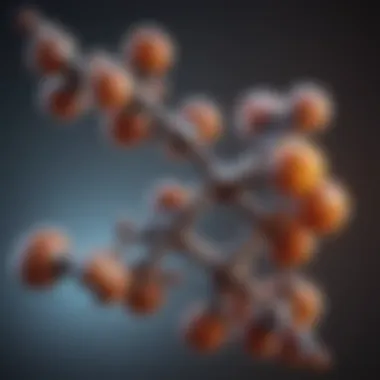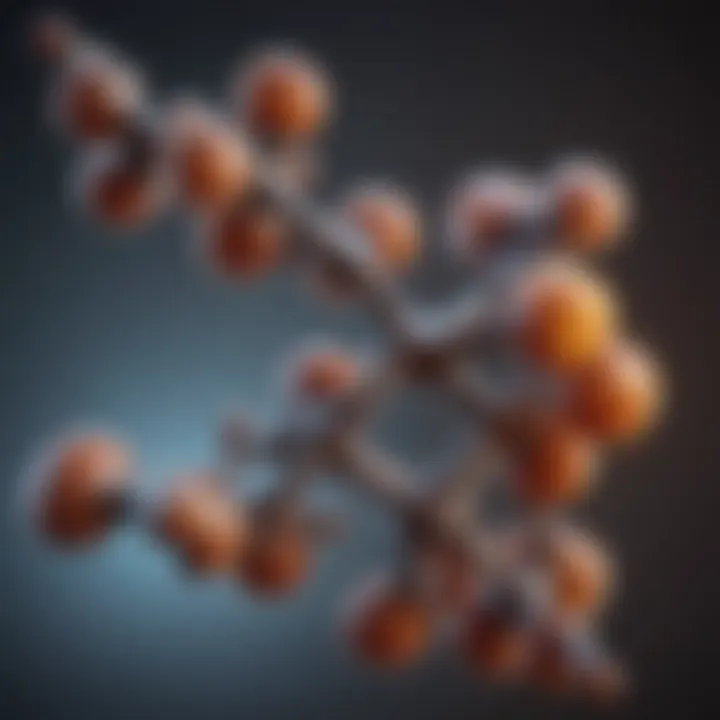Luteinising Hormone's Role in Male Physiology


Overview of Research Topic
Brief Background and Context
Luteinising hormone (LH) plays an essential role in male physiology, emerging from the anterior pituitary gland. As a glycoprotein hormone, it comprises two subunits that form a complete functional unit. LH is primarily responsible for stimulating Leydig cells in the testes to produce testosterone, the principal male sex hormone. This process is vital for the development of male reproductive tissues, including the testes and prostate, as well as for the production of sperm.
The mechanism of LH action involves binding to specific receptors on Leydig cells, triggering a cascade of intracellular events that facilitate testosterone synthesis. Beyond testosterone production, LH's influence is far-reaching, implicating various aspects of male reproductive health, including libido, sperm production, and overall sexual function.
Importance in Current Scientific Landscape
Understanding LH and its functions is crucial, not only for hormonal balance but also for grasping the complexities of male reproductive health. The study of LH is gaining significance amid increasing concerns about reproductive health disorders among males. Fertility rates worldwide are declining, prompting a focused investigation on hormonal contributors like LH.
Abnormal LH levels can signify underlying health issues, including disorders of the pituitary gland, testicular dysfunction, or systemic health problems. Thus, the implications of LH levels in clinical settings are profound, influencing diagnostic and therapeutic strategies for male infertility and other reproductive disorders. This article aims to elucidate these critical relationships, enhancing knowledge in the scientific community and aiding professionals dealing with male reproductive health.
Methodology
Research Design and Approach
This analysis employs a comprehensive literature review approach, synthesizing existing research findings related to luteinising hormone and its roles in male physiology. Various peer-reviewed articles, clinical studies, and relevant healthcare publications are assessed to build a robust understanding of LH’s biochemical properties, mechanisms, and clinical implications.
Data Collection Techniques
Data for this review is garnered from multiple databases, including PubMed and Scopus. Key terms such as "luteinising hormone in males", "LH and testosterone", and "male reproductive health" were utilized to extract pertinent studies. Review articles and meta-analyses provide a variety of perspectives, ensuring a well-rounded collection of current academic discourse.
This section serves as the foundation for diving deeper into the various facets of LH, which will be explored in the subsequent parts of the article.
Prelims to Luteinising Hormone
Luteinising hormone (LH) is a critical component in the complex endocrine processes that govern male reproductive function. LH, produced by the anterior pituitary gland, plays a significant role in stimulating testosterone production in males. Understanding LH is essential for grasping how various physiological mechanisms interact, impacting not only reproductive health but also overall male well-being.
LH's importance extends beyond mere hormone levels. It serves as a key indicator of reproductive health, influencing the balance of testosterone and facilitating spermatogenesis. Abnormal levels of LH can lead to various health issues, such as infertility or other reproductive disorders. Consequently, exploring LH provides insights into both normal physiological functions and the pathophysiology of male reproductive disorders.
Definition and Function
Luteinising hormone is a glycoprotein hormone composed of two subunits, known as the alpha and beta subunits. The beta subunit is unique to LH, allowing for its specific bioactivity. LH's primary function in males is to stimulate the Leydig cells in the testes to produce testosterone. This hormone is essential for numerous biological processes, including the development of secondary sexual characteristics, sexual function, and regulation of sperm production.
In addition to its role in testosterone secretion, LH assists in maintaining sperm quality and quantity. The hormone helps in the maturation of sperm cells, which is vital for male fertility. Moreover, LH acts in synergy with follicle-stimulating hormone (FSH), creating a balanced hormonal environment conducive for reproduction.
Historical Context
The study of luteinising hormone began in the early 20th century, as researchers started to uncover the foundations of the endocrine system. The discovery of LH was pivotal in enhancing our understanding of reproductive physiology. Initial research focused on the pituitary gland's role in hormone production, leading to the identification of various hormones, including LH.
In 1920, the isolation of pituitary extracts marked a significant advancement in endocrinology. These early studies laid the groundwork for later advancements, such as the synthesis of LH analogs and the exploration of its functions in both male and female reproductive health.
As research progressed, scientists began to elucidate the intricate feedback mechanisms controlling LH release. Discoveries regarding the hypothalamic-pituitary-gonadal axis elucidated how LH interacts with hypothalamic hormones to regulate its secretion. This historical perspective highlights the evolving understanding of LH's role in reproductive physiology and its significance in clinical settings today.
Biochemistry of Luteinising Hormone
Understanding the biochemistry of luteinising hormone (LH) is essential to grasp its vital role in male physiology. LH is a glycoprotein hormone composed of two subunits, alpha and beta. This structure is crucial as the beta subunit is unique to LH and dictates its biological activity. Recognizing the chemical makeup aids in elucidating how LH functions within the endocrine system, particularly in reproductive health.
Chemical Structure
Luteinising hormone belongs to the family of gonadotropic hormones, which also includes follicle-stimulating hormone (FSH) and human chorionic gonadotropin (hCG). The alpha subunit is identical across all gonadotropins, while the beta subunit is what differentiates LH from others. The molecular weight of LH is approximately 30 kDa, making it relatively small compared to other hormones.


The glycosylation of LH, which involves the addition of carbohydrate chains to its structure, affects its stability and bioactivity. This modification enhances the hormone’s half-life and facilitates its interaction with the luteinising hormone receptor, primarily located in Leydig cells of the testes.
Synthesis and Secretion
The synthesis of luteinising hormone occurs in the anterior pituitary gland. This process is regulated mainly by gonadotropin-releasing hormone (GnRH) released from the hypothalamus. GnRH pulsatile release induces LH secretion in a similar fashion, meaning that frequencies of GnRH pulses can significantly influence LH levels.
Once synthesized, LH follows a specific secretion pattern. In males, it is secreted in pulses, with levels rising during nocturnal periods and responding to various stimuli like stress or increased testosterone levels. The feedback loops that govern LH secretion are intricate. For instance, elevated testosterone can inhibit LH release through negative feedback mechanisms. Moreover, factors such as age and general health can also alter LH synthesis and secretion patterns.
Important Note: Abnormal levels of LH can be indicative of various disorders affecting reproductive health. Monitoring LH levels can provide crucial insights into male fertility issues and hormonal imbalances.
Role of Luteinising Hormone in Male Reproduction
Luteinising hormone (LH) plays a pivotal role in male reproduction, serving as a key regulator of various physiological processes. Its primary functions are centered on the stimulation of testosterone production and the facilitation of spermatogenesis. Understanding the mechanisms through which LH operates is crucial for those involved in the fields of endocrinology and reproductive health. Analyzing this hormone’s role illuminates not only male reproductive biology but also the potential implications of LH dysregulation.
Testosterone Production
Testosterone is a hormone integral to male reproductive health, influencing not only libido but also secondary sexual characteristics. LH, secreted by the anterior pituitary gland, acts on the Leydig cells in the testes, leading to increased production of testosterone. The relationship is direct; when LH binds to its receptors on these cells, it triggers a cascade of biochemical reactions that enhance testosterone synthesis. This process underscores the significance of LH in maintaining normal hormonal balance in men.
- Impact on Health:
- Clinical Implications:
- Adequate levels of testosterone are essential for normal development and maintenance of male reproductive function.
- Testosterone deficiency can lead to physical and psychological alterations, including diminished sexual desire, fatigue, and mood disorders.
- Evaluating serum LH levels can provide insights into testosterone production status.
- An imbalance can indicate various disorders, ranging from pituitary adenomas to testicular dysfunction.
Spermatogenesis
Spermatogenesis is the biological process through which spermatozoa are produced, a critical component of male fertility. LH contributes to this process indirectly by stimulating testosterone production, which is crucial for the maturation of sperm. The interplay between LH and testosterone facilitates several aspects of spermatogenesis,
- Stimulation of Sertoli Cells: Testosterone acts on Sertoli cells, which support and nourish developing sperm. This interaction is vital for both the quantity and quality of sperm produced.
- Continual Support: LH not only initiates the testosterone synthesis but sustains its levels throughout the reproductive cycle, ensuring that spermatogenesis occurs regularly.
"The regulation of sperm production is critical for male fertility. Proper LH levels are essential for adequate testosterone secretion and consequently for efficient spermatogenesis."
In summary, LH's role in male reproduction cannot be overstated. As a primary regulator of testosterone production and a supporter of spermatogenesis, it is central to maintaining male reproductive health. Imbalances in LH can lead to significant reproductive issues, emphasizing the need for further research into therapeutic strategies that target this hormone. This understanding serves not only to enhance reproductive health but also to inform clinical practices in treating male fertility disorders.
Regulatory Mechanisms of Luteinising Hormone
The regulatory mechanisms of luteinising hormone (LH) are crucial for maintaining male reproductive health. These mechanisms ensure that LH levels are finely tuned to promote optimal function in various physiological processes. A deep understanding of these regulatory pathways can provide insights into how disruptions might lead to reproductive disorders. This section outlines the primary elements of LH regulation, emphasizing the roles of the hypothalamus, feedback loops, and interactions with other hormones.
Hypothalamic Control
The hypothalamus plays a pivotal role in controlling LH secretion. It releases gonadotropin-releasing hormone (GnRH) in a pulsatile manner. This pulsatile release is essential because it results in the stimulation of the anterior pituitary to produce LH. If GnRH were released continuously, it could lead to decreased LH production due to receptor downregulation.
Furthermore, the frequency and amplitude of GnRH pulses influence LH release directly. Variations in these parameters can be due to various factors, including stress, nutrition, and overall health.
As a result, the hypothalamus acts as a critical regulatory center, connecting hormonal signals to the body's reproductive needs.
Feedback Loops
Feedback loops are vital in maintaining hormonal balance, particularly concerning LH levels. Negative feedback primarily regulates LH in males, mainly through testosterone. When testosterone levels rise, they exert a negative feedback effect on both the hypothalamus and the pituitary gland, leading to decreased release of GnRH and LH. This balance helps maintain homeostasis in testosterone production.
On the other hand, positive feedback can also occur under certain conditions, especially during puberty when the body requires significant increases in hormone levels. Thus, understanding these feedback mechanisms is essential in deciphering conditions such as hypogonadism and hypergonadism, where LH production may be disrupted.
Influence of Other Hormones
Various hormones influence LH levels beyond the primary actions of GnRH. For instance, inhibin B, produced by the Sertoli cells in the testes, has a negative feedback effect on FSH. While inhibin primarily regulates FSH, it indirectly influences LH levels due to the interrelated nature of the hormonal axes. Additionally, estrogen, particularly in males, can impact LH regulation. Elevated estrogen levels can diminish LH secretion through negative feedback mechanisms.
Moreover, stress hormones such as cortisol can suppress LH secretion, demonstrating the entwined nature of the endocrine system. Understanding how LH interacts with other hormonal factors again highlights the complexity of the reproductive system and underscores the importance of comprehensive evaluations in clinical settings.


Understanding the regulatory mechanisms of luteinising hormone is essential for grasping its overall role in male reproductive health.
Physiological Impact of Luteinising Hormone Levels
The levels of luteinising hormone (LH) play a critical role in male physiology. A balance in LH levels is fundamental for the maintenance of testosterone production and overall reproductive health. An abnormal LH level can lead to various functional consequences affecting male fertility and hormonal regulation. Understanding these physiological impacts provides valuable insights into potential health issues and their treatment options.
Normal LH Levels
Normal LH levels are essential for healthy male reproductive function. In adult males, LH is secreted by the anterior pituitary gland and regulates testosterone production in the Leydig cells of the testes. The normal range of LH in adult males typically falls between 1.5 to 9.3 mIU/mL.
Maintaining LH within this range ensures optimal testosterone levels, which support multiple physiological functions, including:
- Sexual function: Proper testosterone levels are vital for libido and erectile function.
- Muscle strength: Testosterone contributes to muscle mass maintenance and strength.
- Bone density: Adequate testosterone levels help in preventing osteoporosis.
Implications of normal LH levels: When LH levels are within the normal range, the male body can function properly in terms of reproduction and overall health. Ensuring that these levels are regularly monitored can prevent potential issues in male reproductive health, especially as men age.
Hypogonadism
Hypogonadism refers to a condition where the body does not produce enough testosterone due to low LH levels. This can be of two types: primary hypogonadism, where the issue is in the testes, and secondary hypogonadism, resulting from inadequate stimulation by the pituitary gland.
Some common symptoms of hypogonadism in males include:
- Decreased libido: A significant drop in sex drive may occur.
- Fatigue and depression: Low testosterone levels are linked to fatigue and mood changes.
- Reduced muscle mass: Testosterone is crucial for muscle development and strength.
The diagnosis of hypogonadism typically involves blood tests to measure LH along with testosterone levels. Treatment usually focuses on testosterone replacement therapy, which can alleviate symptoms and restore normal physiological function, while also addressing LH levels if low.
Hypergonadism
On the opposite end, hypergonadism, characterized by elevated LH levels, can lead to excessive testosterone production. This condition may arise from various causes, such as testicular tumors or certain medical conditions like Klinefelter syndrome.
Symptoms of hypergonadism can include:
- Increased aggression: High testosterone may affect mood and behavior.
- Overdevelopment of muscles: Increased testosterone can lead to excessive muscle hypertrophy.
- Infertility: Ironically, while testosterone levels are high, sperm production may be disrupted.
Management of hypergonadism usually requires identifying and treating the underlying condition causing elevated LH and testosterone. It is important to monitor and evaluate these levels regularly to avoid potential complications.
Regular assessment of LH levels can provide critical insights into male reproductive health.
In summary, understanding the physiological impact of luteinising hormone levels in males is essential for maintaining reproductive health. Evaluating both hypo- and hypergonadism allows for appropriate interventions, ensuring men can achieve optimal physiological balance.
Clinical Relevance of Luteinising Hormone
Luteinising hormone (LH) plays a crucial role in the clinical landscape of male reproductive health. Understanding its relevance is essential for diagnosing disorders and addressing fertility issues. LH serves as a marker for various hormonal and reproductive conditions and helps guide treatment protocols in clinical settings. Abnormal LH levels can indicate a spectrum of disorders, making it important to monitor and analyze these levels in patients.
LH in Diagnosing Disorders
Luteinising hormone is instrumental in diagnosing several endocrine disorders. When a physician suspects imbalances in the endocrine system, measuring LH levels can provide valuable insights. Elevated or decreased LH concentrations may point to conditions such as hypogonadism or hypergonadism.
- Hypogonadism: In this condition, low testosterone levels prompt the pituitary gland to increase LH production. Elevated LH may suggest primary hypogonadism, where the testicular function is impaired. Conversely, low LH levels in conjunction with low testosterone might indicate secondary hypogonadism, implying a problem with the pituitary or hypothalamic functions.
- Hypergonadism: High levels of LH can result from conditions like testicular tumors or Leydig cell hyperplasia, leading to excessive testosterone production. In this instance, the clinical significance of high LH serves as an indicator of male reproductive health.
- Klinefelter Syndrome: This genetic disorder impacts male fertility and is characterized by abnormal chromosome numbers. Patients often show elevated LH levels due to impaired testicular function, making LH testing an important diagnostic tool in this context.
In summary, measuring LH is vital in identifying underlying disorders that affect male reproductive capabilities. It is a simple yet effective approach that helps form a clearer understanding of the patient's health status. Regular monitoring may also assist in assessing treatment efficacy.
Impact on Male Fertility
Luteinising hormone is a key player in male fertility. Its impact can be seen in various aspects of reproductive health, influencing testosterone synthesis and subsequently, sperm production. The relationship between LH and fertility is complex, as optimal LH levels are essential for maintaining reproductive health.


- Testosterone Production: LH stimulates the Leydig cells in the testes to produce testosterone. This hormone is crucial for spermatogenesis, the process through which sperm is produced. Insufficient LH can lead to decreased testosterone levels, resulting in impaired spermatogenesis and fertility issues.
- Sperm Maturation: Testosterone, regulated by LH, is integral for the maturation of sperm. Low testosterone levels can result in reduced sperm count and quality, which can hinder the ability to conceive.
- Fertility Treatments: Understanding LH levels aids in developing treatment strategies for men struggling with infertility. Hormonal treatments may be administered to restore normal LH levels and improve testosterone and sperm production. In some cases, human chorionic gonadotropin (hCG) may also be utilized for its LH-like effects.
"An understanding of LH levels can significantly influence the diagnostic approach to male infertility and guide effective treatment options."
Therapeutic Approaches Targeting Luteinising Hormone
Therapeutic approaches targeting luteinising hormone (LH) are crucial in managing various male reproductive health issues. Understanding these therapies helps clinicians and researchers to achieve better outcomes for male patients, particularly in fertility treatments and hormonal regulation. LH modulation enables the treatment of conditions linked to hormonal imbalances, underscoring the importance of LH in male physiology.
The clinical strategies for addressing LH levels often revolve around addressing the underlying causes of hormonal disruption. Treatment modalities can be broadly classified into hormonal treatments and pharmacological interventions. Each of these has specific implications and outcomes for male health.
Hormonal Treatments
Hormonal treatments typically seek to either enhance or suppress LH secretion. This adjustment depends heavily on the condition being treated. For cases of hypogonadism, where low testosterone levels are present, substitutive therapies often involve administering synthetic testosterone. This approach leads to reduced levels of LH due to negative feedback on the hypothalamus and pituitary gland. Conversely, therapies aimed at boosting fertility may employ gonadotropin-releasing hormone (GnRH) analogues to stimulate the pituitary gland to produce more LH. The following benefits and considerations highlight the importance of these treatments:
- Improvement in Testosterone Levels: Hormonal therapies can significantly raise testosterone levels, aiding in better sexual function and increasing muscle mass.
- Enhanced Spermatogenesis: Increasing LH levels through treatment helps in stimulating spermatogenesis, thereby improving fertility potential.
- Monitoring and Adjustments: Regular monitoring is necessary to avoid potential side effects, including elevated estrogen levels from excessive testosterone.
Utilizing hormonal treatments requires a deep understanding of the patient's specific hormonal background. It is crucial to tailor therapies based on individual profiles to maximize benefits without incurring adverse effects.
Potential Pharmacological Interventions
Pharmacological interventions target LH through various mechanisms. Medications can regulate LH levels by influencing hormonal pathways or altering feedback systems in the body. Here are key aspects of this approach:
- GnRH Agonists and Antagonists: These compounds can either stimulate or inhibit LH release. Depending on treatment goals, they can be used in conditions like prostate cancer where reducing LH is beneficial or in cases of infertility where stimulation is needed.
- Aromatase Inhibitors: These medications lower estrogen levels by inhibiting the aromatase enzyme. By reducing estrogen, the negative feedback on LH release decreases, causing levels to rise. This approach is sometimes used in male patients interested in bodybuilding or those with specific endocrine issues.
- Selective Estrogen Receptor Modulators (SERMs): These drugs can increase endogenous LH production by blocking estrogen’s effect in parts of the hypothalamus and pituitary. This results in an increase in both LH and testosterone levels, particularly beneficial in treating male hypogonadism.
"The therapeutic targeting of LH represents a significant advancement in the management of male reproductive health issues, enhancing not only hormonal balance but also overall quality of life."
Pharmacological treatments can provide novel approaches to managing male reproductive health disorders. However, careful assessment is necessary to ensure that potential side effects and contraindications are accounted for.
Current Research on Luteinising Hormone
Research on luteinising hormone (LH) plays a crucial role in understanding male reproductive health. The evolving landscape of scientific investigation has revealed various aspects of LH, including its functions, regulatory mechanisms, and implications for male fertility. This section highlights recent findings and future research directions, emphasizing the significance of these studies for both clinical practice and basic science.
Recent Findings
Recent studies have provided critical insights into the actions of luteinising hormone beyond its established roles in testosterone production and spermatogenesis. Notably, advancements in our understanding of LH receptor signaling have opened new avenues for therapeutic interventions.
- Genetic Studies: Researchers have examined the genetic variations that influence LH levels and LH receptor activity. Variations in genes associated with the LH receptor can affect receptor sensitivity, leading to either hyperactive or hypoactive responses to LH. This could help elucidate mechanisms behind male infertility.
- Exercise and LH Levels: The relationship between physical activity and LH levels is garnering attention. Studies indicate that regular exercise may enhance LH secretion, contributing positively to overall testosterone levels. This link proposes a model for lifestyle interventions in managing hormonal health.
- Endocrine Disruptors: New evidence suggests that endocrine-disrupting chemicals can impair LH secretion. These findings are significant, especially in the context of environmental exposure and its long-term effects on male reproductive health. Understanding the correlation between these external factors and LH dynamics is vital for developing public health strategies.
"The understanding of luteinising hormone continues to evolve, highlighting the necessity of research to explore its broader impacts on male health."
- Age-related Changes: Increased attention is focused on how aging alters LH levels. Researchers have found that while LH levels rise with age, the expected rise in testosterone does not always correspond. This dissonance can result in symptoms associated with hypogonadism, even in the presence of elevated LH.
Future Directions
As research progresses, several key areas warrant further exploration. The following directions could enhance our understanding of luteinising hormone and its implications for male health:
- Longitudinal Studies: More long-term cohort studies are needed to assess how LH levels impact male health over time, particularly concerning fertility and metabolic health. This will provide a clearer picture of the relationship between LH and the onset of age-related conditions.
- Novel Therapeutics: There is potential for developing targeted therapies that modulate LH activity, especially for treating conditions like hypogonadism. Drug discovery focusing on LH analogs or receptor modulators could present new treatment options for patients.
- Cross-Disciplinary Research: Interdisciplinary studies combining endocrinology, environmental science, and epidemiology could shed light on the multifactorial influences of LH. This includes how lifestyle, genetics, and environment converge to influence male reproductive hormone dynamics.
- Biomarkers of Health: Identifying LH as a biomarker for male reproductive health can streamline diagnostics. Efforts to standardize testing methods and interpret LH levels in conjunction with other hormones will strengthen clinical assessments.
End
Additionally, the clinical relevance of LH extends beyond diagnosis. Its implications for therapeutic approaches ensure that researchers and healthcare providers prioritize LH in their strategies to address male reproductive disorders. In contemporary research, recognizing the nuances of LH opens avenues for innovative treatments and deeper evaluations of male reproductive functions.
Summary of Key Points
- Luteinising Hormone Function: LH plays a pivotal role in testosterone production and male reproductive processes.
- Regulatory Mechanisms: The hormone's release is tightly controlled by the hypothalamus through feedback loops, with other hormones influencing LH secretion.
- Clinical Implications: Abnormal LH levels can indicate various health issues, highlighting its importance in diagnostics and treatment.
- Research Potential: Ongoing studies reveal new insights into LH's role, pointing to future developments in endocrine therapies.
Significance for Ongoing Research
The significance of LH in ongoing research cannot be overstated. The exploration of this hormone opens discussions not only in endocrinology but also in related fields like reproductive biology and urology. Current findings suggest that further investigation into LH's functions could reveal more about its impact on mental health and well-being.
Research into targeted therapies aiming to modulate LH levels shows promise. These could eventually lead to regenerative treatments for fertility issues, offering hope for men facing reproductive challenges. By continuously analyzing LH, the scientific community can develop a more holistic understanding of male health, fostering advancements in both preventive and therapeutic measures.



